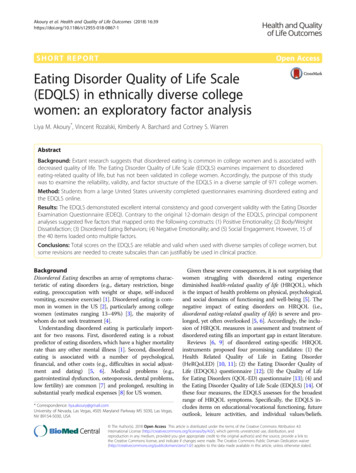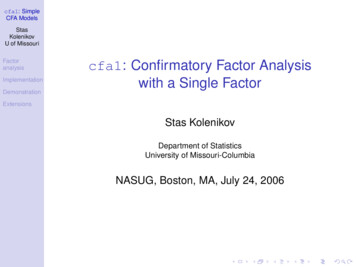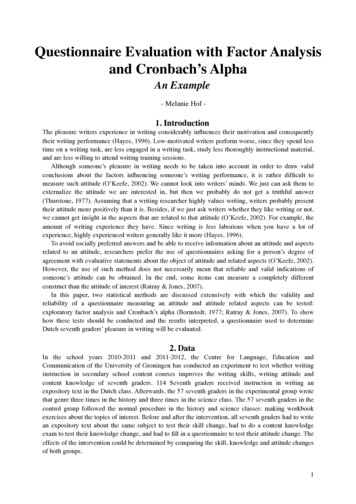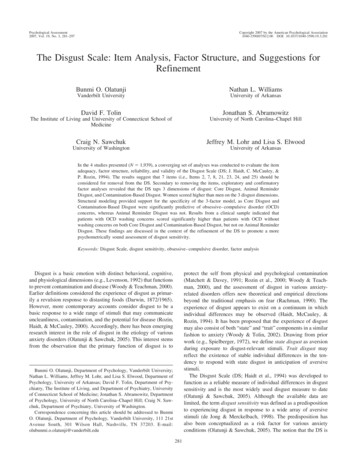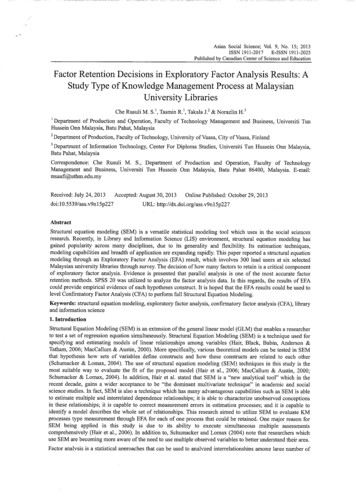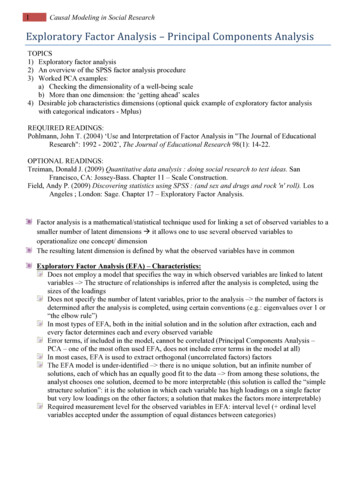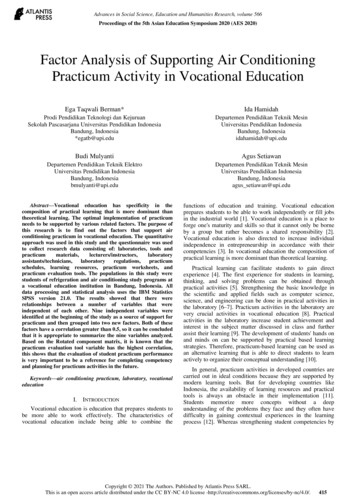
Transcription
Advances in Social Science, Education and Humanities Research, volume 566Proceedings of the 5th Asian Education Symposium 2020 (AES 2020)Factor Analysis of Supporting Air ConditioningPracticum Activity in Vocational EducationEga Taqwali Berman*Ida HamidahProdi Pendidikan Teknologi dan KejuruanSekolah Pascasarjana Universitas Pendidikan IndonesiaBandung, Indonesia*egatb@upi.eduDepartemen Pendidikan Teknik MesinUniversitas Pendidikan IndonesiaBandung, Indonesiaidahamidah@upi.eduBudi MulyantiAgus SetiawanDepartemen Pendidikan Teknik ElektroUniversitas Pendidikan IndonesiaBandung, Indonesiabmulyanti@upi.eduDepartemen Pendidikan Teknik MesinUniversitas Pendidikan IndonesiaBandung, Indonesiaagus setiawan@upi.eduAbstract—Vocational education has specificity in thecomposition of practical learning that is more dominant thantheoretical learning. The optimal implementation of practicumneeds to be supported by various related factors. The purpose ofthis research is to find out the factors that support airconditioning practicum in vocational education. The quantitativeapproach was used in this study and the questionnaire was usedto collect research data consisting of: laboratories, tools racticumschedules, learning resources, practicum worksheets, andpracticum evaluation tools. The populations in this study werestudents of refrigeration and air conditioning study programs ata vocational education institution in Bandung, Indonesia. Alldata processing and statistical analysis uses the IBM StatisticsSPSS version 21.0. The results showed that there wererelationships between a number of variables that wereindependent of each other. Nine independent variables wereidentified at the beginning of the study as a source of support forpracticum and then grouped into two new factors. Both of thesefactors have a correlation greater than 0.5, so it can be concludedthat it is appropriate to summarize the nine variables analyzed.Based on the Rotated component matrix, it is known that thepracticum evaluation tool variable has the highest correlation,this shows that the evaluation of student practicum performanceis very important to be a reference for completing competencyand planning for practicum activities in the future.Keywords—air conditioning practicum, laboratory, vocationaleducationI. INTRODUCTIONVocational education is education that prepares students tobe more able to work effectively. The characteristics ofvocational education include being able to combine thefunctions of education and training. Vocational educationprepares students to be able to work independently or fill jobsin the industrial world [1]. Vocational education is a place toforge one's maturity and skills so that it cannot only be borneby a group but rather becomes a shared responsibility [2].Vocational education is also directed to increase individualindependence in entrepreneurship in accordance with theircompetencies [3]. In vocational education the composition ofpractical learning is more dominant than theoretical learning.Practical learning can facilitate students to gain directexperience [4]. The first experience for students in learning,thinking, and solving problems can be obtained throughpractical activities [5]. Strengthening the basic knowledge inthe scientific and applied fields such as computer science,science, and engineering can be done in practical activities inthe laboratory [6–7]. Practicum activities in the laboratory arevery crucial activities in vocational education [8]. Practicalactivities in the laboratory increase student achievement andinterest in the subject matter discussed in class and furtherassist their learning [9]. The development of students' hands onand minds on can be supported by practical based learningstrategies. Therefore, practicum-based learning can be used asan alternative learning that is able to direct students to learnactively to organize their conceptual understanding [10].In general, practicum activities in developed countries arecarried out in ideal conditions because they are supported bymodern learning tools. But for developing countries likeIndonesia, the availability of learning resources and practicaltools is always an obstacle in their implementation [11].Students memorize more concepts without a deepunderstanding of the problems they face and they often havedifficulty in gaining contextual experiences in the learningprocess [12]. Whereas strengthening student competencies byCopyright 2021 The Authors. Published by Atlantis Press SARL.This is an open access article distributed under the CC BY-NC 4.0 license 5
Advances in Social Science, Education and Humanities Research, volume 566providing direct experience can help to teach difficult conceptsand strengthen students to be able to do work comprehensively,which is followed up by in-depth discussion of relevanttheories [13]. The experience of applying practical knowledgecan facilitate students in overcoming/solving problems in theirfuture work [14].The implementation of air conditioning practicum invocational education is carried out based on a learning programplan that has been prepared for one semester. The practicummaterial delivered were: measurement of air temperature,measurement of refrigerant pressure, refrigerant filling,inspection of refrigerant leaks, measurement of electricalquantities, inspection of electrical component functions,installation of AC units, and maintenance of AC units. Allthese activities are designed with actual conditions so thatstudents can realize their knowledge with their real work afterthey graduate. However, there are several obstacles that causepracticum activities to be suboptimal, including: (a) Practicuminstructions are generally recipes that students must do; (b)Practicum activities are often not measured adequately andaccurately; (c) Practicum equipment is often inadequate interms of quantity and specifications; (d) Practicum activitiesrequire a long time; (e) Requires more expensive costs forproviding practical tools and materials; (f) The unavailabilityof adequate laboratory facilities so that practicum activitiescannot be carried out; (g) Lack of supporting staff forpracticum implementation; and (h) Lack of instructor's abilityto design and implement practicum [15–16]. Based on theseexplanations, this study aims to find out the factors that supportthe activities of air conditioning practicum in vocationaleducation.II. METHODSThis study uses a quantitative approach. A questionnairewas created using Google Form and was used to captureresearch data. A total of 31 statement items were arranged on aLikert scale with five answer choices. All statement items haverepresented nine independent variables consisting of:laboratories, practicum tools and materials, ,laboratoryregulations,practicum schedule, learning resources, practicum worksheets,and practicum evaluation tools. The populations in this studywere students of refrigeration and air conditioning studyprograms at a vocational education institution in Bandung,Indonesia. Samples were selected as many as 54 students whohad carried out the air conditioning practicum and filled out thequestionnaire. All questionnaire data collected was thentabulated in Microsoft Excel to facilitate the subsequent dataprocessing. The data is then tested for validity and reliability. Ifall data are valid and reliable, it is followed by a normality test.All data processing and statistical analysis uses the IBMStatistics SPSS version 21.0.The factor analysis procedure using SPSS is as follows: Construct the Correlation Matrix. The analytic processis based on the correlation matrix between the existingvariables. If the determinant approaches 0, then thecorrelation matrix between the variables is interrelated.so factor analysis can be used. Kaiser-Meyer-Olkin Measure of Sampling Adequacy(KMO-MSA) and Bartlett's Test. KMO is useful formeasuring the feasibility of the sample and Bartlett'stest of sphericity is used to test the accuracy of thefactor model. The requirements are if the KMO value isgreater than 0.50 and the value of Bartlett's Test ofSphericity (Sig.) 0.05, then the factor analysistechnique can be continued. Anti-image matrices. This indicator is to determine theadequacy of the number of samples per variable. Antiimage matrices are recommended values above 0.5which can be seen in the output marked "a" in the antiimage correlation column. Communalities. This is a value that indicates thecontribution of a number of variables to the factorsformed. The greater the communalities of a variable, themore closely related the factors formed. Total Variance Explained. This output is useful fordetermining the number of factors that can be formedby a number of variables. The explanation can be seenin the Eigenvalues as a condition to be a factor, wherethe Eigenvalues must be 1 and the amount of variancethat can be explained by the factor with a number offorming variables. Scree plot. The Scree Plot image shows the number offactors formed. You do this by looking at the value ofComponent points that have an Eigenvalues 1. Component Matrix. This indicator shows the loadingfactor value of each variable against the factor. LoadingFactor is a value that shows correlation of a variable tothe factor formed. Rotated component matrix. This output is to ensure thata variable belongs to a group of factors. The method canbe determined by looking at the largest correlation valuebetween variables and the factors formed. Component Transformation Matrix. This indicator is toshow the accuracy of the factors in summarizing allexisting variables. Correlation factor value must be 0.5.III. RESULTS AND DISCUSSIONThe results of the factor analysis using the IBM StatisticsSPSS version 21.0 produce several assumptions that can beused to find relationships between a number of variables thatare independent of each other so that one or several sets ofvariables can be made that are fewer than the number of initialvariables. In this case the variables that have the greatestcorrelation will group to form a set of variables called a factor.416
Advances in Social Science, Education and Humanities Research, volume 566A. Determinant of Correlation MatrixTable 1 the Determinant of Correlation Matrix shows theresults of calculating the correlation value between the testsTABLE I.LaboratoryTools and materialsLecturer / instructorLaboratory assistant /technicianCorrelatiLaboratory regulationsonPracticum scheduleLearning resourcesPracticum worksheetsPracticum evaluationtoolLaboratoryTools and materialsLecturer / instructorLaboratory assistant/technicianSig. (1Laboratory regulationstailed)Practicum scheduleLearning resourcesPracticum worksheetsPracticum evaluationtoola. Determinant .008DETERMINANT OF CORRELATION MATRIXLaboratoryTools andmaterialsLecturer /instructorLaboratoryassistant 40.344.498.251.282.673.4451.000PracticumLearning Practicumevaluationresources .015.086.001.003.000.000.000.005.000.034.019.000B. KMO and Bartlett's testTable 2 shows the KMO and Bartlett's test. The KMOnumber appears to be 0.813. Because the value is 0.813 0.5,this shows the adequacy of the sample. The KMO and Bartlett'stest (the chi-square value) are 237.914 with a significancevalue of 0.000. This shows that there is a correlation betweenvariables and is feasible for further processing. Furthermore, tofind out which variables can be further processed and whichcan be issued can be seen in the Anti-image matrices output.TABLE II.variables. Based on the data, the value of the Determinant ofCorrelation Matrix is 0.008. Because this value is close to 0,the correlation matrix between variables is thus interrelated.KMO AND BARTLETT’S TESTKaiser-Meyer-Olkin Measure of Sampling Adequacy.Bartlett's Test of SphericityApprox. Chi-SquaredfSig.813237.91436.000C. Anti-Image MatricesTable 3 Anti-Image Matrices, look at the Anti ImageCorrelation section, seen the numbers marked with “a” that.000indicate the amount of MSA of a variable. Laboratory variables0.776, tools and materials 0.891, lecturer/instructor 0.844,laboratory assistant/technician 0.830, laboratory regulations0.636, practicum schedule 0.726, learning resources 0.880,practicum worksheets 0.943, and practicum evaluation tool0.788. All MSA values of each variable are 0.5, then allvariables can be processed further.D. CommunalitiesTable 4 Communalities displayed the value of a laboratoryvariable of 0.611. This means that around 61.1% of thevariance in laboratory variables can be explained by thefactors formed. The tools and materials variable is 0.597, so itcan be interpreted that 59.7% of the variants of the tools andmaterials variable can be explained by the factors formed.Explanation for other variables is done in the same way. Thesmaller the value of communalities means the weakerrelationship with the factors formed.417
Advances in Social Science, Education and Humanities Research, volume 566TABLE III.LaboratoryLaboratoryTools and materialsLecturer / instructorLaboratory assistant /Anti-image technicianconvenance Laboratory regulationsPracticum scheduleLearning resourcesPracticum worksheetsPracticum evaluation toolLaboratoryTools and materialsLecturer / instructorLaboratory assistant /Anti-image techniciancorrelation Laboratory regulationsPracticum scheduleLearning resourcesPracticum worksheetsPracticum evaluation toolANTI-IMAGE MATRICESTools and Lecturer /materials instructorLaboratoryassistant racticumLearning Practicumevaluationresources .223-.335-.098.788aa. Measures of Sampling Adequacy (MSA)TABLE IV.COMMUNALITIESVariablesLaboratoryTools and materialsLecturer / instructorLaboratory assistant / technicianLaboratory regulationsPracticum scheduleLearning resourcesPracticum worksheetsPracticum evaluation toolExtraction Method: Principal Component Analysis.InitialTABLE V.ComponentInitial EigenvaluesTotal% of 0001.0001.000TOTAL VARIANCE EXPLAINEDExtraction Sums of Squared LoadingCumulative Extraction method: Principal Component .7831.155% of Variance58.14312.834E. Total Variance ExplainedTable 5 Total Variance Explained shows the value of eachvariable analyzed. In this study there were nine variablesanalyzed. There are two types of analysis to explain a variant,namely Initial Eigenvalues and Extraction Sums of SquaredLoadings. In the Initial Eigenvalues variants indicate thefactors formed. If all the factors added together indicate thenumber of variables (i.e. 4.783 1.155 0.715 0.600 Rotation Sums of Squared LoadingCumulative %Total58.14365.9783.9692.369% of Variance39.65926.319Cumulative %39.65965.9780.540 0.462 0.348 0.229 0.168 9). While in theExtraction Sums of Squared Loadings section shows thenumber of variations or the number of factors that can beformed. In the output results above there are two variations offactors which are 4.783 and 1.155, respectively. Furthermore,based on the Total Variance Explained output table in theInitial Eigenvalues section, there are two factors that can beformed from the nine variables analyzed. The EigenvaluesComponent 1 value is 4.783 1, then called factor 1 and is418
Advances in Social Science, Education and Humanities Research, volume 566able to explain 47.83% of variation. While the value ofEigenvalues Component 2 is 1.155 1 then it is called factor 2and is able to explain 11.55% variation. If the factors 1 andfactor 2 are added together they are able to explain 59.38% ofthe variation.F. Scree PlotFigure 1 Scree plot shows the number of factors formed.The limit value of the factor forming Eigenvalues is 1, if lessthan 1 means that there are no factor forming variables. Thus,from the graph it appears that there are 2 factors formed. Thismeans the same as the results of the previous definitionH. Rotated Component MatrixTo ensure which variables are included in which factorgroup, it can be determined by looking at the value of thelargest correlation between variables and factors (Components)that are formed. Based on the data shown in Table 7 Rotatedcomponent matrix, the results of the rotational model factoranalysis can be explained as follows: The practicum evaluation tool variable. The correlationvalue of this variable to factor 1 0.787 and factor 2 0.049. Because the correlation value of factor 1 factor2, the practicum evaluation tool variable is part of thefactor 1 group. Laboratory variables. The correlation value of thisvariable to factor 1 0.755 and factor 2 0.203.Because the correlation value of factor 1 factor 2, thelaboratory variable is part of the factor 1 group. Variable practicum worksheets. The correlation value ofthis variable to factor 1 0.744 and factor 2 0.164.Because the correlation value of factor 1 factor 2, thepracticum worksheets variable is part of the factor 1group. Variable learning resources. The correlation value ofthis variable to factor 1 0.732 and factor 2 0.238.Because the correlation value of factor 1 factor 2, thelearning resources variable is part of the factor 1 group. tion value of this variable to factor 1 0.676 andfactor 2 0.482. Because the correlation value of factor1 factor 2, the laboratory assistant / technicianvariable is part of the factor 1 group.Fig. 1. Scree plot.TABLE VI.COMPONENT MATRIXVariablesLaboratory assistant/technicianLecturer/instructorTools and materialsLearning resourcesLaboratoryPracticum schedulePracticum worksheetsPracticum evaluation toolLaboratory regulationsExtraction method: principal component analysis.A. 2 components 670.547.002.165-.041-.229-.271.505-.296-.415.696G. Component MatrixTable 6 Component Matrix shows the value of thecorrelation or relationship between each variable with thefactor to be formed. As can be seen in the output table that thelaboratory assistant/technician variable has a correlation valueof the variables to factor 1 and factor 2 of 0.830 and 0.002,respectively. For other variables, the meaning is done in thesame way. Variable tools and materials. The correlation value ofthis variable to factor 1 0.653 and factor 2 0.413.Because the correlation value of factor 1 factor 2, thetools and materials variable is part of the factor 1 group. Variable laboratory regulations. The correlation valueof this variable to factor 1 0.044 and factor 2 0.885.Because the correlation value of factor 2 factor 1, thevariable laboratory regulations are part of the factor 2group. Variable practicum schedule. The correlation value ofthis variable to factor 1 0.305 and factor 2 0.835.Because the correlation value of factor 2 factor 1, thepracticum schedule variable is part of the factor 2group. Variable lecturer / instructor. The correlation value ofthis variable to factor 1 0.559 and factor 2 0.599.Because the correlation value of factor 2 factor 1, thelecturer/instructor variable is part of the factor 2 group.419
Advances in Social Science, Education and Humanities Research, volume 566TABLE VII.ROTATED COMPONENT MATRIXVariablesComponent12Practicum evaluation tool.787Laboratory.755Practicum worksheets.744Learning resources.732Laboratory assistant/technician.676Tools and materials.653Laboratory regulations.044Practicum schedule.305Lecturer/instructor.559Extraction Method: Principal Component Analysis.Rotation Method: Varimax with Kaiser Normalization.aa. Rotation converged in 3 RENCES[1][2]Referring to the discussion above, the distribution ofvariables included in each factor formed is: Factor 1: practicum evaluation tools, laboratories,practicum worksheets, learning resources, laboratoryassistants/technicians, tools and materials. Factors 2: laboratory regulations, practicum schedule,lecturer / instructor.I. Component Transformation MatrixTable 8 Component Transformation Matrix shows that incomponent 1 the correlation value is 0.816 0.5, andcomponent 2 the correlation value is 0.816 0.5. Because thecorrelation of all components 0.5, the two factors formed canbe concluded feasible to summarize the nine variablesanalyzed.TABLE VIII.ACKNOWLEDGMENTThis research is a part of the dissertation topic in Technicaland Vocational Education Study Program, School ofPostgraduate Studies, Universitas Pendidikan Indonesia[3][4][5][6][7][8][9]COMPONENT TRANSFORMATION MATRIX[10]Component11.8162-.578Extraction Method: Principal Component Analysis.Rotation Method: Varimax with Kaiser Normalization.2.578.816[11][12]IV. CONCLUSIONResearch on factor analysis of supporting air conditioningpracticum in vocational education has been carried out. Nineindependent variables were identified at the beginning of thestudy as a source of support for the practicum and afteranalyzing the data they grouped into two new factors. Both ofthese factors have a correlation value greater than 0.5, so it canbe concluded that it is appropriate to enclose the nine variablesanalyzed. Variable practicum evaluation tool has the highestcorrelation; this shows that evaluating student performanceduring practicum activities is very important to be a referencefor achieving competency and planning for practicum activitiesin the future.[13][14][15][16]V.K. Klotz, S. Billett, and E. Winther, “Promoting WorkforceExcellence: Formation and Relevance of Vocational Identity forVocational Educational Training,” Empirical Research in VocationalEducation and Training, 6(1), pp. 1–20, 2014.A. Edmon, and A. Oluiyi, “Reenginering Technical VocationalEducation and Training Toward Safety Practice Skill Needs of SawmillWorkers Against Workplace Hazards in Nigeria,” J. of Edu. and Prac.,Vol. 5(7), pp. 150-157, 2014.O.O. Kennedy, “Philosophical and Sociological Overview of VocationalTechnical Education in Nigeria,” College Student Journal, Vol. 46(2),pp. 274-283, 2012.M.R. Matthews, “History, Philosophy, and Science Teaching: ThePresent Rapprochement,” Science & Education, Vol. 1(1), pp. 11-47,1992.B.D. Coller, “An Experiment in Hands-on Learning in EngineeringMechanics: Statics,” Int. J. of Eng. Edu., Vol. 24(3), pp. 545-557, 2008.J. Ma, and J.V. Nickerson, “Hands-on, Simulated, and RemoteLaboratories: A Comparative Literature Review,” ACM ComputingSurveys (CSUR), Vol. 38(3), pp. 7, 2006.T. De Jong, M.C. Linn, and Z.C. Zacharia, “Physical and VirtualLaboratories in Science and Engineering Education,” Science, Vol.340(6130), pp. 305-308 , 2013.M.J. Scott, S. Counsell, S. Lauria, S. Swift, A. Tucker, M. Shepperd, andG. Ghinea, “Enhancing Practice and Achievement in IntroductoryProgramming with a Robot Olympics,” IEEE Trans. on Edu., Vol. 58(4),pp. 249-254, 2015.C. Tuysuz, “The Effect of The Virtual Laboratory on Students’Achievement and Attitude in Chemistry,” Int. Online J. of Edu. Sci.,Vol. 2(1), pp. 37-53, 2010.H.J. Duda, “Pembelajaran Berbasis Praktikum dan Asesmennya padaKonsep Sistem Ekskresi untuk Meningkatkan Kemampuan BerpikirKritis Siswa Kelas XI,” J. VOX Edukasi, Vol. 1(2), pp. 29-39, 2010.S.R. Tazkia, and A. Suherman, “Optimalisasi Fasilitas Alat Praktikuntuk Mencapai Tuntutan Kompetensi Siswa SMK,” J. of Mech. Eng.Edu., Vol. 3(2), pp. 263-269, 2016.I. Kukliansky, and H. Eshach, “Evaluating a Contextual-based Courseon Data Analysis for The Physics Laboratory,” J. of Sci. Edu. and Tech.,Vol. 23(1), pp. 108-115, 2014.M.P. Clough, “Using The Laboratory to Enhance Student Learning,”Learning science and the science of learning, pp. 85-94, 2002.H. Posadas, and E. Villar, “Using Professional Resources for TeachingEmbedded SW Development,” IEEE Revista Iberoamericana deTecnologias del Aprendizaje, Vol. 11(4), pp. 248-255, 2016.A. Hofstein, and V.N. Lunetta, “The Laboratory in Science Education:Foundation for The Twenty First Century,” Sci. Edu., Vol. 88(1), pp. 2854, 2004.Y. Yenita, M. Mugisukmawati, and Z. Zulirfan, “Hambatan PelaksanaanPraktikum IPA Fisika yang Dihadapi Guru SMP Negeri di KotaPekanbaru,” J. Pendidikan, Vol. 3(1), pp. 994, 2012.420
Statistics SPSS version 21.0. The factor analysis procedure using SPSS is as follows: Construct the Correlation Matrix. The analytic process is based on the correlation matrix between the existing variables. If the determinant approaches 0, then the correlation matrix between the variables is interrelated. so factor analysis can be used.
